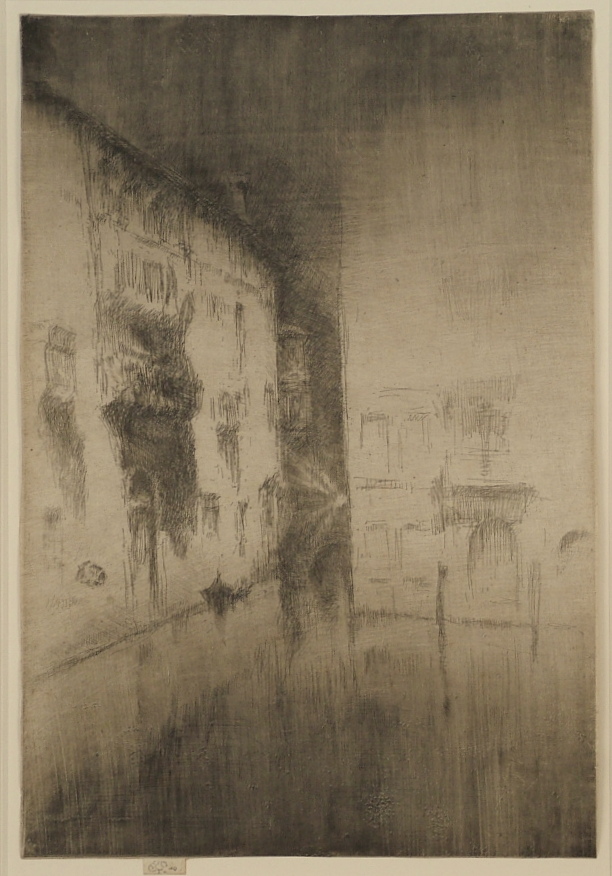Nocturne: Palaces
James Whistler (1834-1903), Nocturne: Palaces, etching and drypoint with plate tone, 1879-80, signed with the butterfly on the tab and inscribed “imp.” Also with a second butterfly in pencil verso, and the artist’s tiny circle device (signifying a selected proof). Reference: Glasgow 200, twelfth state (of 12), Kennedy 202, ninth state (of 9). From the Twenty-Six Etchings, the Second Venice Set. In very good condition (scattered light foxing verso, not visible recto), on laid paper (trimmed by the artist to the platemark except for the tab), 11 3/4 x 7 7/8 inches.
Watermark: Coat of Arms of Amsterdam
Provenance:
Kennedy Galleries (with their stock number a53836 verso
Ch. E. Ellingwood (Lugt 822, verso)
A superb, luminous impression, printed in brown ink, carefully wiped to darken the water in the canal in the foreground and the sky toward the top.
It is rather unusual for Whistler to sign his prints verso (as well as recto); this is sometimes considered evidence of a selected proof, as is his adding of one or more tiny circles. Of course Whistler was a practiced marketer, so such added markings are not always indicative of anything; and in any case they are quite unnecessary as proof of the quality of this impression.
In this state, in the words of the Glasgow catalogue, “considerable shading is added to the left side of the image, most notably: on the sky between the left and centre palaces and the wall of the right palace; under the eaves of the left palace; on the balcony, shadow and doorway of the left palace; on the centre palace, seen behind the bridge; around the beams eminating from the lamp; on the bridge, the shadow beneath it and its reflection; and on the reflection of the gondola.” These additions heighten the features of the palaces, the bridge, and the lamplight, which were losing focus in prior states.
Each impression of Nocturne: Palaces is different from the others, in effect a monotype, expressing different times of night or day, temperatures, effects of light. The lamp lighting the composition from within (a device borrowed from Rembrandt and also used in his Street at Saverne of 1858) is in this impression quite visible; in other impressions it is pale and nearly lost. This impression is in some ways comparable to an impression (also of the last state) at the Metropolitan Museum of Art in New York (pictured in Katherine A. Lochnan’s book The Etchings of James McNeill Whistler) although of course there are still substantial differences in the wiping of the plate tone. Indeed, differences in states for this print can be slight, while differences in the wiping of the plate from one impression to another are vast.
Margaret MacDonald in her classic Palaces in the Night: Whistler in Venice amplifies: “Nocturne: Palaces was a daring plate: difficult to print, relying heavily on the quality of the ephemeral drypoint lines…in the best impressions it is the inking of the plate that coordinates and unifies the widely dispersed lines of shading. The linear pattern of marks is unusual and the inking makes each print unique.”
